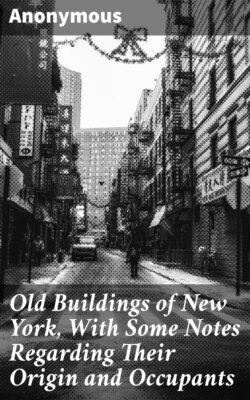Читать книгу Old Buildings of New York, With Some Notes Regarding Their Origin and Occupants - Anonymous - Страница 8
На сайте Литреса книга снята с продажи.
ОглавлениеSt. Paul’s Chapel
Table of Contents
This chapel built in 1764–66 is the oldest church edifice in the city. The first rector was the Rev. Dr. Barclay, who was succeeded by the Rev. Dr. Samuel Auchmuty. The steeple is in the style of one of Wren’s designs. After the burning of Trinity in 1776, it was used as the parish church. The pews that during the war held Howe, André, the officers of the army of occupation, and the young midshipman who later became King William IV were, when peace was concluded, occupied by the former “rebels” Washington, Clinton, and their followers. After his inauguration, in the Federal Hall in Wall Street, Washington and the members of both houses came in solemn procession to St. Paul’s, where services were conducted by Bishop Provost, Chaplain of the Senate, and a Te Deum was sung.
The square pew on the left with the national arms on the wall was the one used by Washington as long as New York remained the capital. The corresponding pew on the right, designated by the arms of the State, was that of Governor Clinton. On the chancel wall are marble tablets to Sir John Temple, the first British consul general, and to Colonel Thomas Barclay, the eminent loyalist, son of the Rev. Dr. Barclay, rector of Trinity Parish. Colonel Barclay succeeded Temple as consul general of “His Brittanick Majesty.” There is also a tablet in memory of the wife of William Franklin, Tory Governor of New Jersey, and several others. The only other reminder of pre-Revolutionary days is the gilded crest of the Prince of Wales over the pulpit canopy. As everyone knows, at the east end of the yard facing Broadway are monuments to three eminent Irishmen who rose to distinction in this country—Emmet, Montgomery, and MacNeven, one at the bar, another in the army, and the third in medicine. Emmet was the brother of the Irish martyr, Robert Emmet;12 Montgomery settled in New York before the Revolution, married a daughter of Chancellor Livingston and fell at Quebec;13 MacNeven, like Emmet, had taken part in the Irish rebellion of ’98, acting with him as one of the Directory of Three. Both were imprisoned at Fort George in Scotland. He later served in Napoleon’s army as surgeon.
George W.P. Custis, who was one of Washington’s family, spoke of St. Paul’s as being “quite out of town.” No doubt the great fire of 1776, which stopped when it got to the Chapel yard, left the Chapel standing isolated from buildings below it; but Custis, to get there from St. George’s (Franklin) Square, must have had to go some distance “down town.” It tends to show that the water front of the city was covered with buildings before the central part. The fact that the commissioners for making a plan of the future city early in the last century arranged for so many streets running to the water and for so few running north and south would also seem to indicate that they thought easy access to the rivers was of prime importance.
Mr. Astor, with his wonderful foresight, was the first man to realize that the “backbone” of the island was, in after years, to show the greatest advance in the value of real estate.
